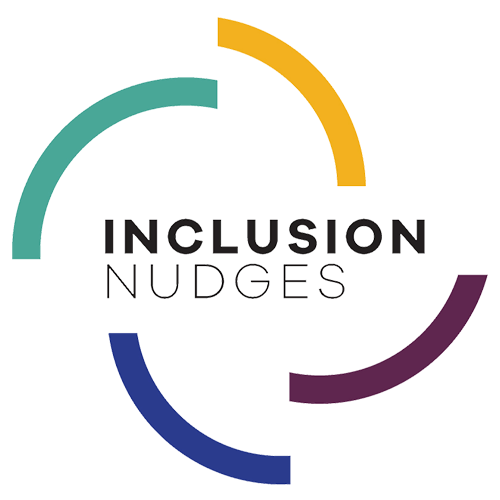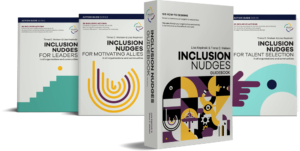What a tumultuous time the past two years have been! The pandemic-era (which we are still in) has been a massive, rapid-paced experimentation with new ways of working. It has brought about a profound shift in how we think about work and the future. There are still many open questions and evolving data. We have written an article series covering some of the emerging trends that we’ve categorised as ‘Purpose’, ‘People’, ‘Process & Policy’, and ‘Polarisation & Activism’. Plus, we share reflection questions on what these shifts might mean for DEI in your context during this highly ambiguous, fast-changing time.
This is the article covering the PROCESS & POLICY trends. You can also read the other 3 articles (PEOPLE, POLARISATION & ACTIVISM and PURPOSE) on the Inclusion Nudges blog, as well as the full article.
Process & Policy
In times of change, we can often see more clearly where the status quo is no longer the status needed for current and emerging times. This is a valuable opportunity to assess, design, and experiment with new solutions.
The pandemic brought heightened attention on where work is performed and how it gets done. This is causing major upheavals in the social contract between employees and employers. Workers now have a lower acceptance of things as the norm like workplace ‘presenteeism’, long office commutes, formal clothing codes, poor working conditions, unfair compensation, abuse, discrimination, a false belief in meritocracy, low control over their work, always-on availability expectations, business travel, feelings of isolation, a lack of well-being and psychological safety, no gender equality for family care, and much more.
We now see more clearly that we’ve been in unhealthy workplaces based on outdated norms no longer fitting our current realities.
Now is the time for organisations to re-set and communicate their policies for where and how work happens.
Let’s address one of the biggest policy shifts—work location
There is a lot of emerging, and often conflicting, data on who wants to work remotely. But what does come through in each study is that there is at least one group of people (such as by generation, gender, level, etc.) who express a desire to continue working online. In the U.S., remote work is projected to continue at least one day a week and “the desire for flexible work is strongest among women, working parents and employees of color, who have shown gains in employee experience scores while working remotely.” This will likely have wide “social ramifications, including greater employee diversity, a better work-life balance and larger talent pools, as location and in-office presence become less important.”
However, many employees (estimates at 2/3’s of workers) are expecting much more than one day a week and willing to quit if remote work isn’t the norm. Pre-pandemic, many organisations had an ad hoc approach to who gets to work remotely which allowed for biases, placed a heavy decision burden on the manager, made it unlikely for the employee to bring the request forward, and generally wasn’t perceived as fair. In 2019, global research that Lisa & Veronika Hucke did on where and how work is done showed that the vast majority of remote workers were more senior males in the organisation, with working mothers feeling the stigma of asking for this way of working option, and more junior staff wanting remote work but feeling that they don’t dare ask for it out of fear of being seen as ‘not serious about their job’. Now’s the time to get this right after we’ve just had a massive global experience with remote work.
But how that policy gets created is as important as having one, if not more so. An approach that is designed in isolation risks not being fit for purpose, with low acceptance and usage, and may exacerbate inequalities. According to a multi-country survey of knowledge workers, absurdly leaders are not harnessing the very knowledge of their knowledge workers in how work will be going forward; 66% of executives reported that they are designing post-pandemic workforce policies with little to no direct input from their employees! And this isolated approach to new work policies is leading to overconfidence in 66% of executives believing that they are being “very transparent”, but only 42% of workers agree. You can almost see this being doomed from the start. What a loss for getting it right by not engaging the people it’s about in an inclusive process!
Our collective pandemic-era call to action is that policies need to be assessed if they fit the current state and future direction, use data and input from all in the organisation to co-create the new solution that integrates behavioural insights, and implement with agile experimentation.
Reflective questions
- How is your organisation engaging (co-creating with) all of the staff in crafting the future work policy?
- Have you defined the purpose of the office? What would necessitate or be the benefit of coming to the office to work?
- What is the default of your work location policy—office-based, remote, hybrid, etc.?
- If (when) you have a clear work location policy, how is it communicated so all understand it?
- Do you have a checklist for decisions on the policy? (Checklists help to lessen bias.)
- Are managers and employees prepared with tools and skills to work remotely or in a hybrid model?
Closing Notes:
Thank you to Barry Phillips for inviting Lisa to give an HR Master Class as part of Legal Island’s support for DEI change makers. In that September 2021 session, Lisa presented some of these pandemic-era research trends and led a discussion on what it could mean for DEI.
We hope this summary of research on emerging workplace trends from the pandemic-era has sparked new areas to reflect upon as you focus on DEI and inclusive leadership in your organisations. If you would like to engage us for advisory consulting, coaching, and speaking, please do reach out to us at contact@inclusion-nudges.org
These Inclusion Nudges can support reflection:
Reveal Gaps in Flexible Working to Increase Use by All in The Inclusion Nudges Guidebook and Inclusion Nudges for Motivating Allies
Flexible Working as the Default & Norm in The Inclusion Nudges Guidebook, Inclusion Nudges for Leaders, & Inclusion Nudges for Talent Selection
Default as ‘All Jobs Are 80% Jobs’ in The Inclusion Nudges Guidebook & Inclusion Nudges for Talent Selection
Want to read more? See these other blog articles:
SERIES: The Pandemic-Era Shifts in Work & DEI: Read the other 3 articles in this series (PEOPLE, POLARISATION & ACTIVISM and PURPOSE), as well as the FULL ARTICLE.
Ask Lisa & Tinna: How Do I Create New Inclusive Workplace Models?
Reframe Language on How We Work Today
Ask Lisa & Tinna: How Can We Ensure Intersectionality is Best Reflected in KPIs







